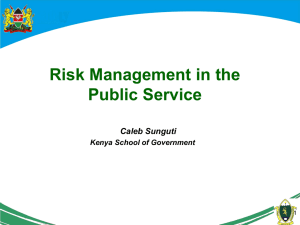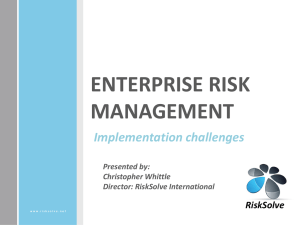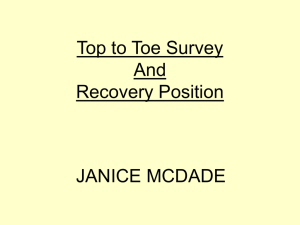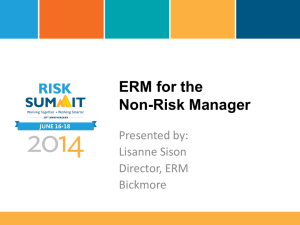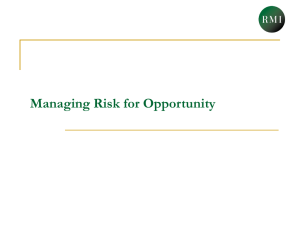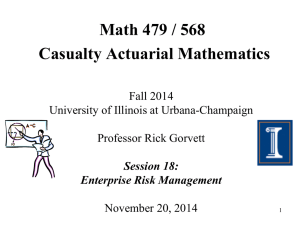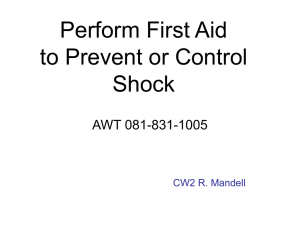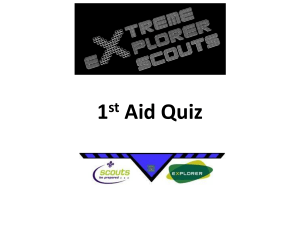Monthly Written Premiums
advertisement
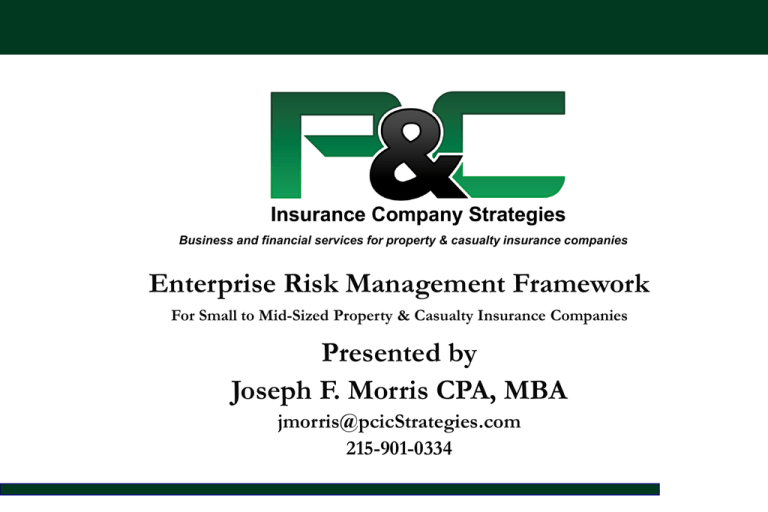
Business and financial services for property & casualty insurance companies Enterprise Risk Management Framework For Small to Mid-Sized Property & Casualty Insurance Companies Presented by Joseph F. Morris CPA, MBA jmorris@pcicStrategies.com 215-901-0334 Learning Goals Recent Regulatory Developments 2013 Holding Company Registration Statement on Governance and Internal Controls 2014 Form F (Enterprise Risk Management Report) 2015 Own Risk Solvency Assessment 2016 Corporate Governance Annual Filing (Proposed) Expectations of Rating Agencies Definition and Benefits of ERM Framework Business and Financial Services for Property and Casualty Insurance Companies 2 Learning Goals (continued) Creating a Risk-Aware Culture Setting Tone at the Top Defining Risk Profile, Risk Appetite and Risk Tolerance Levels Roles and Responsibilities Reporting and Monitoring Determining Key Risk Factors Five Categories of Risk Risk Tolerance Parameters Controls or Monitoring Activities Issues for Remediation Risk Factor Dashboard Business and Financial Services for Property and Casualty Insurance Companies 3 ERM – Regulatory Developments NAIC’s Solvency Modernization Initiative and Risk-Focused Financial Examinations 2013 Annual Registration Statement Includes: – “the insurer’s board of directors oversees corporate governance and internal controls and that the insurer’s officers or senior management have approved, implemented and continue to maintain and monitor corporate governance and internal control procedures.” 2014 Form F (Enterprise Risk Management Report) 2015 Own Risk Solvency Assessment (ORSA) 2016 Corporate Governance Annual Filing (Proposed) Business and Financial Services for Property and Casualty Insurance Companies 4 ERM – Regulatory Developments (continued) 2014 Form F (Enterprise Risk Management Report) Filed annually by ultimate controlling person No size exemption “Enterprise Risk in ten areas “Enterprise Risk” is defined as: “Any activity, circumstance, event or series of events involving one or more affiliates of an insurer that, if not remedied promptly, is likely to have a material adverse effect upon the financial condition or liquidity of the insurer or its insurance holding company system…” If no response, must indicate “To the best of its knowledge and belief, Registrant has not identified enterprise risk subject to this disclosure.” Business and Financial Services for Property and Casualty Insurance Companies 5 ERM – Regulatory Developments (continued) 2014 Form F (Enterprise Risk Management Report) Material developments regarding strategy, internal audit findings, compliance or risk management; Acquisition or disposal of insurance entities; Changes of shareholders exceeding 10% or more of voting securities; Developments in investigations, regulatory activities or litigation; Business plan and summarized strategies for next 12 months; Identification of material concerns raised by supervisory college; Identification of capital resources and material distribution patterns; Identification of any negative movement with rating agencies; Information on corporate or parental guarantees; Identification of any material development that could adversely affect the company. Business and Financial Services for Property and Casualty Insurance Companies 6 ERM – Regulatory Developments (continued) 2015 Own Risk and Solvency Assessment Model Law Insurers with less than $500 million in gross written premium and insurance groups with less than $1 billion in gross written premium are exempt; Requires insurers to maintain a risk management framework and complete an ORSA Summary Report; ORSA Summary Report: Section 1 – Description of the Insurer’s Risk Management Framework Section 2 – Insurer’s Assessment of Risk Exposure Section 3 – Group Assessment of Risk Capital and Prospective Solvency Assessment Additional Information – organization chart, basis of accounting, signature of chief risk officer Business and Financial Services for Property and Casualty Insurance Companies 7 ERM – Regulatory Developments (continued) 2016 Corporate Governance Annual Filing Model Law Provide a summary of an insurer’s corporate governance structure, policies and practices No size exemption Annual Filing: Section 1 – Description of Corporate Governance Framework Section 2 – Description of Board of Directors; and Committee Policies and Practices Section 3 – Description of Management Policies and Practices Section 4 – Description of Management and Oversight of Critical Risk Areas Business and Financial Services for Property and Casualty Insurance Companies 8 A.M. Best: ERM in the Rating Evaluation Process Business Profile Operating Performance Enterprise Risk Management is the common thread that links balance sheet strength, operating performance, and business profile Balance Sheet Strength Source: A. M. Best Company 9 A.M. Best ERM Expectations All insurers need to establish an ERM framework ERM capabilities should be proportionate to risk profile of insurer Insurers need to establish firm-wide risk tolerance metrics Insurers need to have their own view of capital adequacy A low risk profile and high ERM capability will produce a ratings “lift” Leading insurers are utilizing stochastic-based capital modeling to better support risk-reward decisions Business and Financial Source: A. M. Best CompanyServices for Property and Casualty Insurance Companies 10 What is an ERM Framework? Enterprise Risk Management Framework Establish Risk-Aware Culture Identify Measure Manage & Mitigate Risks Measure Enterprise Risk and Risk Correlation A disciplined process to systematically identify measure and manage various types of risk Source: A. M. Best Company Business and Financial Services for Property and Casualty Insurance Companies 11 Benefits of Enterprise Risk Management Framework Maximize value to the organization’s various stakeholders Manage exposure to earnings and capital volatility Ensures future capital levels exceed required regulatory capital Create a risk-aware culture that encourages risk-taking Develop consistent metrics to measure risk and to establish risk tolerance levels Assign roles and responsibilities to board, Sr. management and others Maintain excellent rating from rating agencies Business and Financial Services for Property and Casualty Insurance Companies 12 Enterprise Risk Management Risk-Aware Culture ERM – Risk Aware Culture ERM Tone Established by Board of Directors and Senior Management ERM roles and responsibilities clearly defined Define risk profile, risk appetite and risk tolerance parameters Mission, Strategic Planning and ERM documents shared with all employees Executive compensation includes achievement of risk management objectives Financial results and risk management initiatives reviewed with employees Business and Financial Services for Property and Casualty Insurance Companies 14 ERM – Risk Aware Culture (continued) ERM Roles and Responsibilities Board establishes Risk Committee as oversight function Senior Management is responsible for identification, measurement, monitoring and communication of risk goals, metrics and activities Chief Risk Officer is responsible for leading ERM activities within company Reporting of Enterprise Risk Management Activities Quarterly reporting of ERM metrics and activities to Risk Committee of Board of Directors via ERM Dashboard Business and Financial Services for Property and Casualty Insurance Companies 15 ERM Terminology What is Risk Profile? A narrative description of the parameters for executing the company’s business strategy Business and Financial Services for Property and Casualty Insurance Companies 16 ERM Terminology What is Risk Appetite? The boundary level of uncertainty a company is willing to assume given the corresponding reward associated with the risk Business and Financial Services for Property and Casualty Insurance Companies 17 Risk Profile and Risk Appetite Examples External Environment Regulatory Legal/Judicial Economic Industry Competition Capital Management Financial Ratings Access to Capital Debt and Holding Company Structure Capital Adequacy Balance Sheet Loss Reserves Investment Portfolio Written Premium Profile Line of Business, Geographic, Product, Class of Business, Agency Concentration Limits of Liability Coverage Reinsurance Profile Reinsurance Credit Quality CAT Exposure Per Risk Retentions Operational Profile Underwriting & Claim Practices IT Performance, Data Quality & Business Continuity and Recovery Business and Financial Services for Property and Casualty Insurance Companies 18 ERM Terminology What is Risk Tolerance Level? The financial metrics that establish thresholds for levels of risk that the company is willing to accept in order to accomplish its strategic objectives. Business and Financial Services for Property and Casualty Insurance Companies 19 Risk Tolerance Level Examples Enterprise-Wide Risk tolerance Levels Economic Capital Model: Probability of Ruin at 99.5% VaR, OneYear Out Best Capital Adequacy Ratio, One Year Out to Achieve/Maintain ARating NAIC Risk Based Capital Greater Than 300 Net Written Premium to Surplus ratio of Less than 1.5 to1 No Greater Than a 10% Loss of Capital From all Risk Factors in Any One Year Holding Company Debt to Total Capitalization Ratio Business and Financial Services for Property and Casualty Insurance Companies 20 Risk Tolerance Level Examples Individual Risk Tolerance Levels Net of Reinsurance Underwriting per Risk Retention Equal to 5% or Less of Capital (net of tax). Loss and LAE Reserves Set at or Above Mid-Point of Actuarial Range of Estimates No Greater than a 5% Loss of Capital in Any One Year Due to a 100 Basis Change in Interest Rates Business and Financial Services for Property and Casualty Insurance Companies 21 Identification, Measuring and Monitoring Key Risk Factors Primary Causes of Financial Impairment U.S. Property/Casualty – Primary Causes of Financial Impairment (1969-2012) Affiliate problems 8.0% Catastrophe losses 7.1% Reinsurance failure 3.1% Significant change in business Miscellaneous 3.5% 8.4% Investment problems (overstated assets) Alleged fraud 6.6% 7.2% Deficient loss reserves/Inadequate pricing 43.4% Rapid growth 12.6% Note: Exhibit % are based on companies where the cause of impairment was identif ied. Source: A.M. Best data & research Business and Financial Services for Property and Casualty Insurance Companies 23 Key Risk Factor Categories - Definitions Credit - exposure from all potential creditors including agents, reinsurers, bond issuers and insureds Market – exposure to liquidity events, asset/liability mismatches and risks in investment portfolios due to changes in interest rates, equity prices and exchange rates • Underwriting – exposure from underwriting insurance products including: product development, regulation, loss reserves, pricing metrics and catastrophic events • Operational – exposure to management change, business interruption, fraud, data capture and security, claim handling and employee retention and other operating activities • Strategic – exposure to economic downturn, industry competition, rating agencies and availability of capital Business and Financial Services for Property and Casualty Insurance Companies 24 Categories of Key Risk Factors Credit Bond Issuer Default/Downgrade Agency/policyholder credit risk Reinsurer default Sovereign Currency Market Liquidity events Asset / Liability Matching Interest Rate Risk Common Stock Market Price Reinvestment Underwriting Product Development Regulatory Catastrophic Event Loss Reserve Loss Experience Pricing Operational Data Capture/Data Security Agency Automation Management Change/Employee Turnover Fraud/Financial Controls Claim Handling Delegation of Underwriting Authority Financial Reporting Strategic A. M. Best Downgrade Industry Competition Economic Downturn Reputational Capital Availability Competitor technology Advances Business and Financial Services for Property and Casualty Insurance Companies 25 Frequent Occasional Often 8 9 10 4 11 2 5 6 1 7 12 3 Remote Low Possible Probability Probable High ERM Key Risk Factors – Heat Map < 1% Low 1 – 5% 5 – 10% 10 – 15% 15 – 20% >20% Severity of Event (% of Surplus) Business and Financial Services for Property and Casualty Insurance Companies High 26 ERM – #1 Risk Factor: Pricing Dashboard Will be Included in Live Presentation Business and Financial Services for Property and Casualty Insurance Companies 27 Is Your Company Capable of Managing Key Risks? Industry Operating Practices Best Operating Practices Pricing - No price monitoring reports New business and renewal price monitoring reports track manual and discretionary price changes Loss Reserves - Calendar Year Loss Ratio/Loss Reserve Adequacy Reviewed Annually by Outside Actuary Accident Year Loss Ratios/ Loss Reserve Adequacy Reviewed Quarterly Internally and Annually by Outside Actuary CAT Management - Determined annually by reinsurance broker Property Values Managed Monthly in Concentrated Territories Claims Best Practices - No written claims best practices and no claim audit process Written Claims Best Practices and Claim Files Audited Monthly Investment Portfolio - Risk Metrics not calculated Investment Manager Monitors Risk Metrics of Investment Portfolio and Meets with Board Investment Committee Quarterly Financial Forecasts – one-year budgets are created for operating statements only Three-Year Financial Forecasts prepared including operating statements, balance sheets and RBC and BCAR ratios Business and Financial Services for Property and Casualty Insurance Companies 28 Enterprise Risk Management Framework Risk Identification Financial Goals & Capital Management Risk Measurement Risk-Aware Culture Risk Profile Risk Tolerance Roles/Responsibilities ERM Process Business Strategies & Operating Practices Risk Controls, Monitoring Activities & Reporting Integrate ERM Process into Standard Operating Practices of Company Business and Financial Services for Property and Casualty Insurance Companies 29 30 Joseph F. Morris, CPA, MBA Bio Joseph F. Morris, CPA, MBA, has over thirty-four years of insurance industry experience. Prior to founding P&C Insurance Company Strategies, LLC, Mr. Morris was President of Stonecreek Specialty Underwriters, LLC. Previously, Mr. Morris was President and CEO of James River Insurance Company from 2008 until 2010 after serving as President and CEO of The Philadelphia Contributionship, the oldest insurance company in the United States. Mr. Morris also held several positions with United America Indemnity, Ltd. (UAI) including President, President & CEO Penn-America, UAI’s excess & surplus lines subsidiary, and SVP and CFO of Penn-America. Mr. Morris began his insurance career at Reliance Insurance Company where, over a twenty-one year career, he held a number of financial and operating positions. Mr. Morris has been a member of the Board of Directors of The Insurance Society of Philadelphia since 1989 and was its Chairperson in 1997-1999. Joseph F. Morris jmorris@pcicstrategies.com 215-901-0334 www.pcicstrategies.com Business and Financial Services for Property and Casualty Insurance Companies 31 Disclaimer of Warranties The content of this webinar and the presentation materials have been prepared by P&C Insurance Company Strategies, LLC (PCIC Strategies) “as is”, for informational purposes only and without warranties of any kind, either express or implied. PCIC Strategies disclaims all warranties including but not limited to warranties of title, implied warranties of merchantability, fitness for a particular purpose, compatibility, security, accuracy, reliability or infringement. Business and Financial Services for Property and casualty Insurance Companies 32
